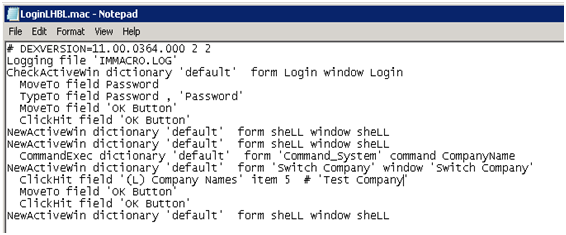Do you run several integrations with Integrations Manager across multiple companies in Microsoft Dynamics GP? Do you find yourself doing repetitive steps to login to Dynamics GP, or switching company then run your integration countless times? Do you wish there’s an easier and more automated way to do this?
Well, fret no more because there is actually a real simple solution to this! And here’s more good news, it’s a free tool!! I recently used this free downloadable program called Autodim.exe to automate an integration that creates a batch AP posting transaction in Dynamics GP for 15 companies. But you can certainly use this program for any type of integration created in Integration Manager that you have.
Once you download, it comes with a 3 page relatively good document (rtf) that tells you how to make use of this tool. It should be easy to follow, thus, no need to repeat all those details again here. That’s what that document is for…but here’s a quick rundown of what you will need:
- The executable program – Autodim.exe
- A macro file for logging into Dynamics GP (*.mac)
- Your source file – this is the text file that Autodim reads which contains the path for the Dynamics.exe and IMRun.exe, your macro and the integration to be run. (*.txt)
More on the macro – How to record the login macro?
These steps can be found in the Integration Manager User Guide Chapter 17
- Start Dynamics GP but do not log in.
- Press ALT+F8 at the Welcome to Microsoft Dynamics GP window. You will get a window to name the macro and save it in a folder.
- Login to Dynamics GP. If the User ID is filled in, remove it and manually type the user id and then the password.
- To stop the recording after you have logged in, go to Tools>Macro>Stop Record.
Here’s a tip of how I created all my macros for all 15 companies:
- Record logging in to one company using the above steps. Save this macro. Your macro will look like this:

- Record one more time logging in to one company and continue recording switching to the next company until you have switched to the last company.
- Create a copy of the first macro file and rename it. Now, all you have to do is replace the line (4th line from end of the file) with the Company Name in this macro. The item # and company name should be in the second recording you created switching to the different companies.
- You would have to repeat step 3 depending on how many companies you need to run the integration to. Also, naming the macro file the same as the company name or an abbreviated version of it or Company ID in GP helps to identify the macro later.
- One last thing…I added the line “Logging file ‘IMMACRO.log’” (2nd line after the # DEXVERSION line) to turn off the OK prompt that would show when you run the macro. Trust me, you will need and add this line.
- Also, the #DEXVERSION line will be or may be different depending on your Dynamics GP version. I am running the latest Dynamics GP 2013 R2 version.
Regarding the source file
Now here’s a typical example of what your source file would look like:
“C:Program Files (x86)Microsoft DynamicsGP2013dynamics.exe” “C:Program Files (x86)Microsoft DynamicsGP2013dynamics.set” C:Projects Login_Company1.mac,C:Program Files (x86)Microsoft DynamicsIntegration Manager 12Microsoft.Dynamics.GP.IntegrationManager.IMRun.exe /I “Integration Company 1”
“C:Program Files (x86)Microsoft DynamicsGP2013dynamics.exe” “C:Program Files (x86)Microsoft DynamicsGP2013dynamics.set” C:ProjectsLogin_Company2.mac,C:Program Files (x86)Microsoft DynamicsIntegration Manager 12Microsoft.Dynamics.GP.IntegrationManager.IMRun.exe /I “Integration Company 2”
(Note: You should have the same number of lines as many as your companies you want to run your integration. I had 15 lines for my 15 companies.)
There are essentially five things you will need per line in the source file:
- The path for your dynamics.exe file – In my example:”C:Program Files (x86)Microsoft DynamicsGP2013dynamics.exe”
- The path for your dynamics.set file – In my case: “C:Program Files (x86)Microsoft DynamicsGP2013dynamics.set”
- The path for your macro file – From my above example: C:ProjectsLogin_Company1.mac
- The path for IMRun.exe – Again, from the example above: C:Program Files (x86)Microsoft DynamicsIntegration Manager 12Microsoft.Dynamics.GP.IntegrationManager.IMRun.exe
- The integration name -/I “Integration Company 1” /S
Parameters:
/I – specifies the integration name
/G – specifies the name of the integration group
/S – specifies to run the integration without showing the progress window
Well, I hope this blog taught you a thing or two on how to use this tool – Autodim.exe. It certainly helped not having to run the integration 15 times manually. Now, you can just sit and watch Autodim do the integration for you! If you want to take the automation further, you can create a batch file to run the Autodim program or create a task scheduler to run it. But that’s for another topic…till next time!
If you are looking to learn more about new functionalities in Microsoft Dynamics GP 2013, contact our professionals at erp@rsmus.com. You can also learn other valuable tips through our Dynamics Community Newsletter. If you found the information useful, please [Tweet this post] and comment below how you are using the tool.
By: Layla Doctor – Illinois Microsoft Dynamics GP partner

 RSMUS.com
RSMUS.com